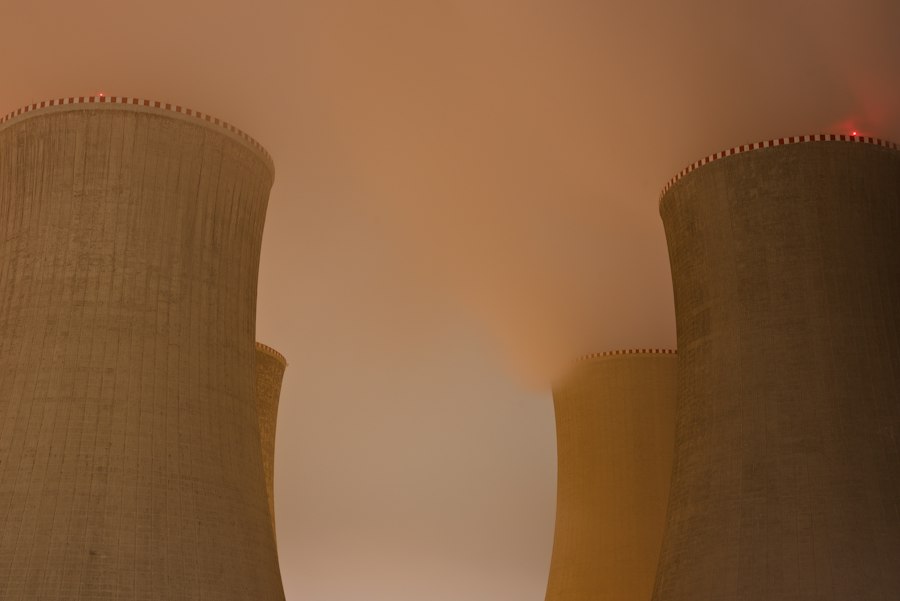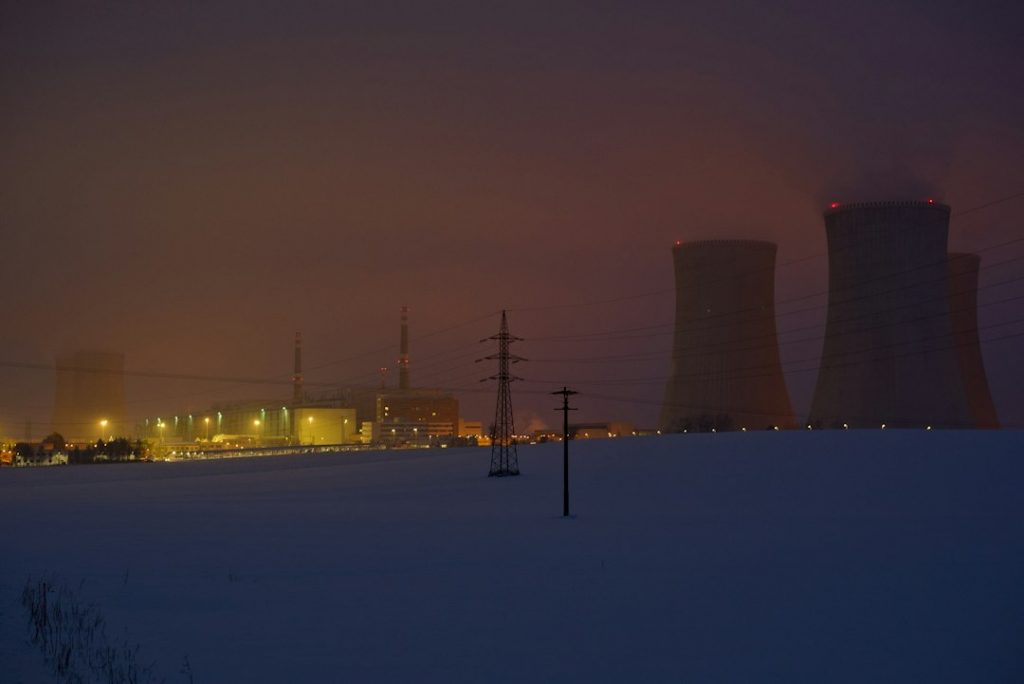Nuclear chemistry is a branch of chemistry that deals with the study of atomic nuclei and the changes they undergo. At its core, nuclear chemistry is concerned with understanding the structure of an atom and the interactions between its constituent particles.
An atom consists of a nucleus, which is made up of protons and neutrons, surrounded by electrons. Protons have a positive charge, neutrons have no charge, and electrons have a negative charge. The number of protons in an atom determines its atomic number, while the total number of protons and neutrons determines its atomic mass.
The nucleus is held together by the strong nuclear force, which is much stronger than the electromagnetic force that repels positively charged protons. The electrons orbit the nucleus in energy levels or shells, and their arrangement determines the chemical properties of an element.
Summary
- Nuclear chemistry is the study of atomic structure and the reactions that occur within the nucleus.
- Marie Curie was a pioneer in the field of nuclear chemistry, and today’s scientists continue to make advancements in the field.
- There are three types of nuclear reactions: fission, fusion, and radioactive decay.
- Nuclear energy has both pros and cons, including its potential for clean energy and the risk of accidents and nuclear waste.
- Radioisotopes are used in medical diagnostics and treatment, but there are also ethical considerations surrounding their use.
The History of Nuclear Chemistry: From Marie Curie to Today’s Nuclear Scientists
Marie Curie is often regarded as the mother of nuclear chemistry. She was a Polish-born physicist and chemist who conducted groundbreaking research on radioactivity in the late 19th and early 20th centuries. Curie discovered two new elements, polonium and radium, and coined the term “radioactivity” to describe the spontaneous emission of radiation from certain elements.
Curie’s work laid the foundation for further research into nuclear chemistry. In 1896, Henri Becquerel discovered that uranium salts emitted radiation that could penetrate opaque materials. This discovery led to further investigations into the nature of radioactivity.
The Manhattan Project, which took place during World War II, was a major milestone in the history of nuclear chemistry. It was a research project that aimed to develop atomic weapons, specifically the atomic bomb. Scientists such as J. Robert Oppenheimer and Enrico Fermi played key roles in this project, which ultimately led to the successful development and deployment of the atomic bomb.
Today, nuclear chemistry continues to be a vibrant field of research. Modern-day nuclear scientists are exploring new ways to harness the power of nuclear reactions for energy production, medical diagnostics and treatment, and other applications. They are also working on developing safer and more efficient nuclear technologies.
The Different Types of Nuclear Reactions: Fission, Fusion and Radioactive Decay
Nuclear reactions involve changes in the nucleus of an atom. There are three main types of nuclear reactions: fission, fusion, and radioactive decay.
Fission is the process in which a heavy nucleus, such as uranium-235 or plutonium-239, is split into two smaller nuclei. This process releases a large amount of energy in the form of heat and radiation. Fission reactions are used in nuclear power plants to generate electricity.
Fusion, on the other hand, is the process in which two light nuclei, such as hydrogen isotopes, combine to form a heavier nucleus. This process also releases a large amount of energy. Fusion reactions are the source of energy in stars, including our Sun. Scientists are currently working on developing practical fusion reactors as a potential source of clean and abundant energy.
Radioactive decay is the spontaneous disintegration of an unstable atomic nucleus. During radioactive decay, an atom emits radiation in the form of alpha particles, beta particles, or gamma rays. This process continues until a stable nucleus is formed. Radioactive decay is used in various applications, including medical imaging and cancer treatment.
Nuclear Energy: The Pros and Cons of Nuclear Power
| Pros of Nuclear Energy | Cons of Nuclear Energy |
|---|---|
| Low greenhouse gas emissions | Potential for nuclear accidents |
| Reliable source of energy | High cost of building and maintaining nuclear power plants |
| High energy output | Long-term storage of nuclear waste |
| Less land use compared to renewable energy sources | Security risks associated with nuclear materials |
| Can reduce dependence on fossil fuels | Public perception and fear of nuclear energy |
Nuclear energy is the energy released during nuclear reactions, particularly fission reactions. It is a highly efficient and reliable source of electricity generation.
One of the main advantages of nuclear power is its high energy density. A small amount of nuclear fuel can produce a large amount of energy. This makes nuclear power plants more compact and efficient compared to other forms of power generation.
Nuclear power is also considered a low-carbon energy source. Unlike fossil fuels, nuclear power does not produce greenhouse gas emissions during operation. This makes it an attractive option for countries looking to reduce their carbon footprint and combat climate change.
However, there are also several disadvantages associated with nuclear power. One of the main concerns is the potential for accidents and the release of radioactive materials. The Chernobyl and Fukushima disasters highlighted the risks associated with nuclear power plants. These accidents resulted in the release of large amounts of radioactive materials, causing significant environmental and health impacts.
Another concern is the long-term management of nuclear waste. Nuclear power plants produce radioactive waste that remains hazardous for thousands of years. The safe disposal of this waste is a major challenge that requires careful planning and implementation.
Nuclear Medicine: How Radioisotopes are Used in Medical Diagnostics and Treatment
Nuclear medicine is a branch of medicine that uses radioisotopes for diagnostic and therapeutic purposes. Radioisotopes are unstable isotopes of elements that emit radiation as they decay.
In medical imaging, radioisotopes are used to create images of the body’s internal structures. For example, technetium-99m is commonly used in single-photon emission computed tomography (SPECT) scans to visualize blood flow and organ function. Positron emission tomography (PET) scans use radioisotopes such as fluorine-18 to detect metabolic activity in tissues.
Radioisotopes are also used in cancer treatment. Radiation therapy involves using high-energy radiation to kill cancer cells and shrink tumors. Radioactive isotopes, such as iodine-131, can be administered orally or intravenously to target cancer cells specifically.
Nuclear Weapons: The Science Behind the Most Destructive Weapons on Earth

Nuclear weapons are the most destructive weapons ever created by humans. They are based on the principles of nuclear reactions and the release of a large amount of energy.
The science behind nuclear weapons involves two main processes: fission and fusion. Fission weapons, also known as atomic bombs, rely on the splitting of heavy atomic nuclei to release a massive amount of energy. Fusion weapons, also known as hydrogen bombs or thermonuclear bombs, use the combination of light atomic nuclei to release an even greater amount of energy.
The impact of nuclear weapons on society is profound. The bombings of Hiroshima and Nagasaki during World War II demonstrated the devastating power of nuclear weapons. The long-term effects of radiation exposure from these bombings continue to be felt today.
Nuclear weapons have also played a significant role in international relations. The possession and development of nuclear weapons by different countries have led to arms races and geopolitical tensions. The threat of nuclear war remains a major concern for global security.
Nuclear Waste: The Challenges of Managing Radioactive Materials
Nuclear waste refers to the radioactive materials produced during nuclear reactions, particularly in nuclear power plants. It is a major challenge to manage and dispose of this waste safely.
One of the main challenges is the long-term storage of nuclear waste. Radioactive materials can remain hazardous for thousands of years, so it is crucial to find suitable storage solutions that can prevent leakage and contamination. Deep geological repositories, such as the one being developed in Finland, are being considered as potential long-term storage sites.
Another challenge is the transportation of nuclear waste. Radioactive materials need to be transported from nuclear power plants to storage or disposal facilities. This requires careful planning and adherence to strict safety protocols to minimize the risk of accidents or radiation exposure.
There are also concerns about the potential risks associated with nuclear waste. If not managed properly, radioactive materials can contaminate soil, water, and air, posing a threat to human health and the environment. It is therefore essential to implement robust safety measures and regulations to mitigate these risks.
Radiation Protection: How to Stay Safe in a World of Nuclear Technology
Radiation exposure can have harmful effects on human health. It is important to take precautions to protect oneself from radiation in a world of nuclear technology.
One of the key principles of radiation protection is the ALARA principle, which stands for “as low as reasonably achievable.” This principle emphasizes the need to minimize radiation exposure to the lowest possible level without compromising the benefits of radiation use.
There are several ways to protect oneself from radiation exposure. For example, wearing protective clothing, such as lead aprons or gloves, can help shield the body from radiation. Using shielding materials, such as lead or concrete, can also reduce radiation exposure.
It is also important to follow safety protocols and guidelines when working with radioactive materials or in environments where radiation is present. This includes proper training, monitoring of radiation levels, and regular maintenance and inspection of equipment.
Radiation protection plays a crucial role in nuclear technology. It ensures the safety of workers in nuclear power plants, medical facilities, and other industries that use radioactive materials. It also helps to minimize the potential risks associated with radiation exposure.
The Future of Nuclear Chemistry: Advancements and Innovations in the Field
Nuclear chemistry continues to evolve and advance, with new discoveries and innovations shaping the future of the field.
One of the latest advancements in nuclear chemistry is the development of advanced reactor designs. These designs aim to improve the safety, efficiency, and sustainability of nuclear power generation. For example, molten salt reactors and small modular reactors are being explored as potential alternatives to traditional nuclear power plants.
Nuclear chemistry also has potential applications in other areas, such as materials science and environmental remediation. Researchers are investigating new materials that can withstand high levels of radiation and developing techniques for cleaning up radioactive contamination.
The field of nuclear chemistry also has a role to play in addressing global challenges, such as climate change and energy security. Nuclear power, if harnessed safely and responsibly, can provide a reliable and low-carbon source of energy. Research in nuclear chemistry can help to improve the efficiency and safety of nuclear power generation.
The Ethical and Moral Considerations of Nuclear Chemistry: Balancing Science and Society
Nuclear chemistry raises important ethical and moral considerations that need to be carefully considered.
One of the main ethical concerns is the potential for accidents and the release of radioactive materials. The Chernobyl and Fukushima disasters highlighted the devastating consequences of nuclear accidents. It is essential to prioritize safety and implement robust regulations to prevent such accidents from happening in the future.
There are also concerns about the proliferation of nuclear weapons. The possession and development of nuclear weapons by different countries can lead to arms races and geopolitical tensions. Efforts to prevent the spread of nuclear weapons, such as the Treaty on the Non-Proliferation of Nuclear Weapons, are crucial for global security.
Balancing the benefits and risks of nuclear chemistry is a complex task. On one hand, nuclear power can provide a reliable and low-carbon source of energy. On the other hand, there are concerns about the long-term management of nuclear waste and the potential risks associated with radiation exposure.
Society plays a crucial role in regulating nuclear technology. Public awareness, engagement, and participation are essential for making informed decisions about the use of nuclear chemistry. It is important to have open and transparent discussions about the benefits, risks, and ethical considerations associated with nuclear technology.
FAQs
What is nuclear chemistry?
Nuclear chemistry is the study of the chemical and physical properties of elements and compounds involved in nuclear reactions.
What are nuclear reactions?
Nuclear reactions are processes that involve changes in the nucleus of an atom, resulting in the formation of a different element or isotope.
What are the types of nuclear reactions?
The types of nuclear reactions include fusion, fission, radioactive decay, and transmutation.
What is nuclear fusion?
Nuclear fusion is the process of combining two atomic nuclei to form a heavier nucleus, releasing a large amount of energy in the process.
What is nuclear fission?
Nuclear fission is the process of splitting a heavy atomic nucleus into two or more lighter nuclei, releasing a large amount of energy in the process.
What is radioactive decay?
Radioactive decay is the process by which an unstable atomic nucleus loses energy by emitting radiation in the form of alpha, beta, or gamma particles.
What is transmutation?
Transmutation is the process of changing one element into another by altering the number of protons in the nucleus through nuclear reactions.
What are the applications of nuclear chemistry?
Nuclear chemistry has applications in nuclear power generation, nuclear medicine, environmental monitoring, and forensic analysis.


